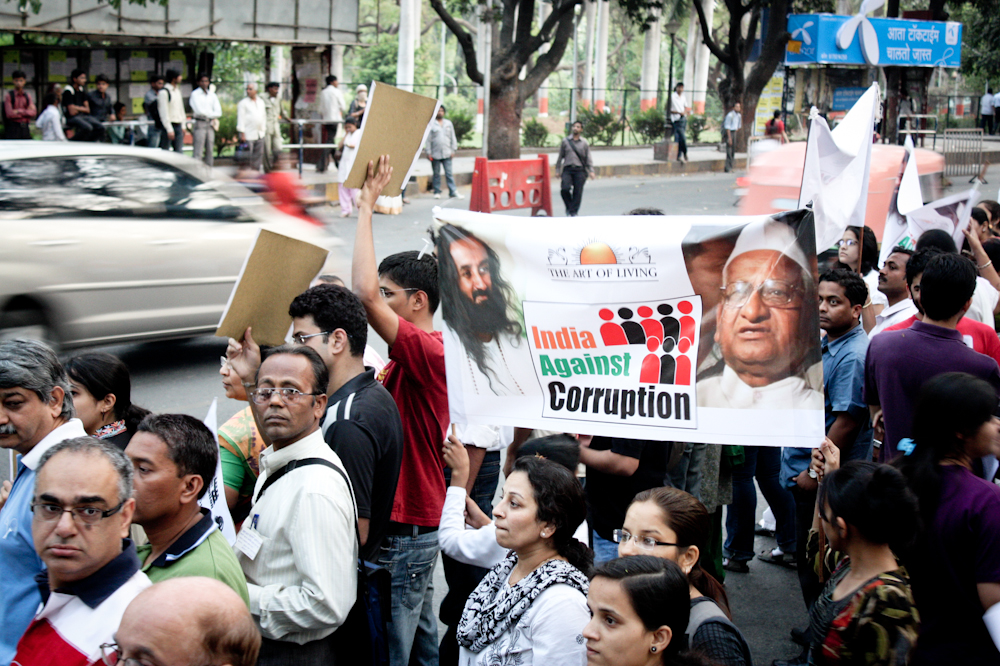Looking at India’s long history of economic inefficiencies brought by endemic and institutionalized corruption, one might be surprised to see the resilient levels of growth throughout the recent global financial crisis despite the extent of graft in the country. In 2015, India ranked 76 of 168 countries in a study by anti-corruption organization Transparency International, and was 130 of 176 countries in terms of ease of business as per the World Bank Group. It loses an estimated USD $ 19 billion annually from activities in the black market.
India’s relationship with corruption is complicated with graft being prevalent at various levels of business affecting consumers, corporations and the government alike. Companies have typically been the largest bribe payers in the economy, often paying government officials for access to discounted licensing privileges, while both corporations and wealthy individuals have been found guilty of engaging in siphoning funds into offshore accounts. Often done by setting up offshore shell companies or subsidiaries as well as establishing accounts in tax havens, companies have become creative in concealing assets by what is known as “mis-invoicing.” “Mis-Invoicing” involves purchasing goods at inflated prices prior to their import from a controlled second party abroad and holding the excess profits in that person’s country. When these offshore assets need to be repatriated, it is done so by “round tripping” or re-investing the assets into a domestic subsidiary via a third party.
Corporations are often involved in funding election campaigns, as in common in most countries, as a means of gaining profitable favour from their supported party when in power. However, this relationship also extends to that between different political parties. Smaller political parties often support larger parties in return for helping members of smaller political parties get rich upon election. There is also plenty of graft at the lower levels of government as well, with citizens frequently having to pay bribes in order to gain access to entitled services such as obtaining licenses, passports, or marriage licences.
Though graft has been relatively absent in the Indian banking system and sales of consumer goods, what’s been interesting is the impact corruption has had on the Indian housing market. From the period of 2002 to 2006, the average property price increased at annualized rates of around 16% which also outpaced average income levels. In spite of the Indian economy’s seeming vulnerability to a collapse in the housing boom during the global financial crisis, within a year the country’s GDP returned to growth rates near 8% from 2009 to 2011. The considerable stability of the housing market is connected to the fact that the majority of housing purchases are made informally in cash. With property sellers typically listing an undervalued price for the property for the sake of formal payments and demanding the rest in cash payments, sellers avoided capital gains taxes, while buyers avoided property taxes since they declared a lower value for the property. Consequently, Indians were burdened with significantly lower mortgages compared to many of their western counterparts during the financial crisis and thus banks were also less exposed to liquidity risk in terms of mortgages.
Although corruption in the Indian housing market perhaps shielded the Indian economy from risk found in much of the rest of the world during the global financial crisis, that is not to say that corruption is at all permissible. In 2011, the current chief economist of the World Bank and former chief economic advisor to India’s ministry of finance, Kaushik Basu, began proposing the legalization of certain forms of bribery as a means of combatting India’s widespread corruption. In his paper entitled, “Why, for a Class of Bribes, the Act of Giving a Bribe Should be Treated as Legal,” Basu argued for the legalization of bribe payments made to obtain legally entitled services, but also makes clear that bribery as a means of gaining favour should remain illegal. He hoped that with legalization, ordinary Indians forced into paying bribes would be empowered to report such illegal activities with the protection of legal immunity. Under current laws, it is in the interest of both parties to keep incidents of bribery secret, as both the victim and extortionist are subject to being convicted of acts relating to bribery.
As of now, the Indian government has taken measures such as increasing online services to reduce bribery levels and increase transparency in government activities and it is also developing an electronic ID system for the poor to receive direct financial aid through their bank accounts. However, if the government intends to get serious on corruption, larger institutional reforms will be needed and legal reforms offering better incentive and protection for those who wish to report cases of forced bribery.




